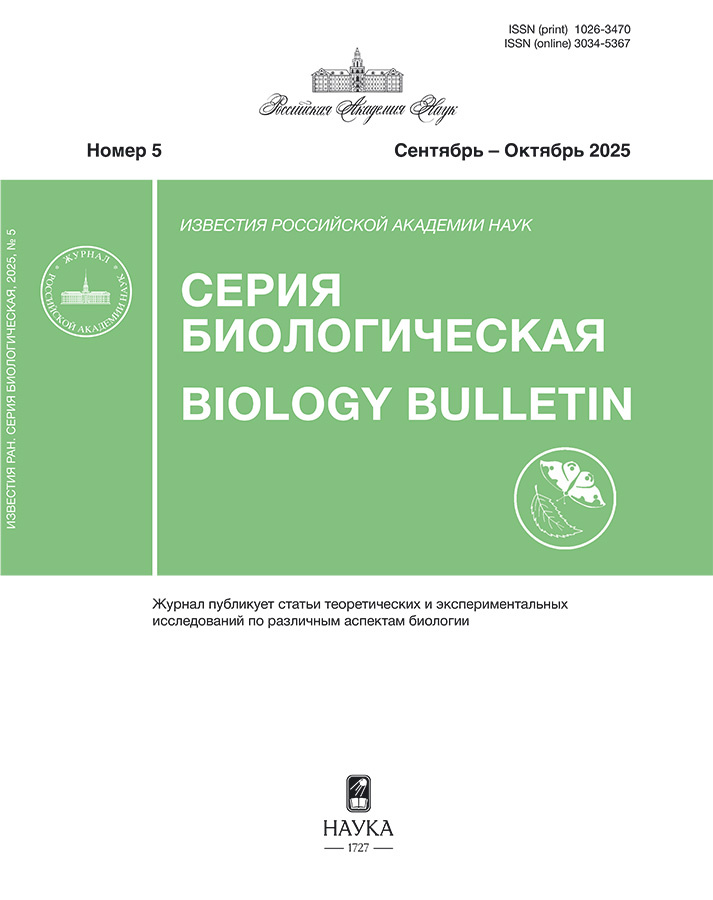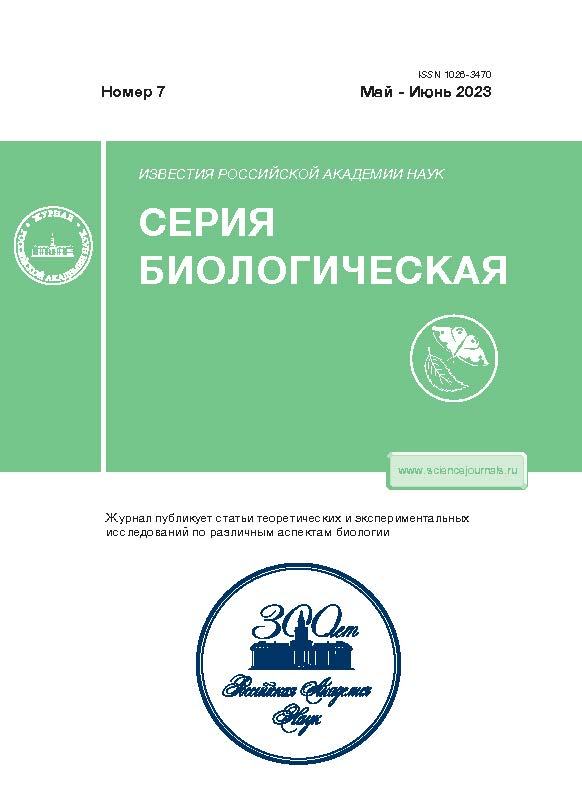Стабильность развития, популяционная динамика и изменение климата (на примере исследования обыкновенной бурозубки (Sorex araneus L., 1758) в Центральной Сибири)
- Авторы: Захаров В.М.1, Трофимов И.Е.1, Якушов В.Д.2, Шефтель Б.И.2
-
Учреждения:
- Институт биологии развития им. Н.К. Кольцова РАН
- Институт проблем экологии и эволюции им. А.Н. Северцова РАН
- Выпуск: № 7 (2023)
- Страницы: 23-28
- Раздел: УСТОЙЧИВОСТЬ БИОЛОГИЧЕСКИХ СИСТЕМ: ОРГАНИЗМ
- URL: https://cardiosomatics.ru/1026-3470/article/view/647730
- DOI: https://doi.org/10.31857/S1026347023600164
- EDN: https://elibrary.ru/VGKQSU
- ID: 647730
Цитировать
Полный текст
Аннотация
Проведена оценка показателей стабильности развития (величины флуктуирующей асимметрии краниологических признаков) обыкновенной бурозубки (Sorex araneus L., 1758) в Центральной Сибири в ходе популяционной динамики. В этой популяции четырехлетние циклы в прошлом столетии сопровождались нарушением стабильности развития на фазе пика численности. Флуктуации численности в условиях изменения климата в этом столетии наблюдаются без значительных изменений стабильности развития. Нарушение стабильности развития имеет место лишь в случае эффекта переуплотнения в год высокой численности, превышающей определенный пороговый уровень, который мог возрасти вследствие роста емкости местообитаний в условиях изменения климата.
Ключевые слова
Об авторах
В. М. Захаров
Институт биологии развития им. Н.К. Кольцова РАН
Email: trofimov@ecopolicy.ru
Россия, 119334, Москва, ул. Вавилова, 26
И. Е. Трофимов
Институт биологии развития им. Н.К. Кольцова РАН
Автор, ответственный за переписку.
Email: trofimov@ecopolicy.ru
Россия, 119334, Москва, ул. Вавилова, 26
В. Д. Якушов
Институт проблем экологии и эволюции им. А.Н. Северцова РАН
Email: trofimov@ecopolicy.ru
Россия, 119071, Москва, Ленинский пр., 33
Б. И. Шефтель
Институт проблем экологии и эволюции им. А.Н. Северцова РАН
Email: trofimov@ecopolicy.ru
Россия, 119071, Москва, Ленинский пр., 33
Список литературы
- Захаров В.М. Асимметрия животных: популяционно-феногенетический подход. М.: Наука, 1987. 216 с.
- Захаров В.М., Жданова Н.П., Кирик Е.Ф., Шкиль Ф.Н. Онтогенез и популяция: оценка стабильности развития в природных популяциях // Онтогенез. 2001. Т. 32. № 6. С. 404–421.
- Захаров В.М., Трофимов И.Е. Оценка состояния биоразнообразия: исследование стабильности развития. М.: Товарищество научных изданий КМК, 2019. 160 с.
- Захаров В.М., Шефтель Б.И., Дмитриев С.Г. Изменение климата и популяционная динамика: возможные последствия (на примере мелких млекопитающих в Центральной Сибири) // Успехи современной биологии. 2011. Т. 131. № 5. С. 435–439.
- Шефтель Б.И., Якушов В.Д. Влияние потепления климата на наземные виды средней енисейской тайги // Сибирский экологический журн. 2022. Т. 1. С. 1–12.
- Aars J., Ims R.A. Intrinsic and climatic determinants of population demography: The winter dynamics of tundra voles // Ecology. 2002. V. 83. P. 3449–3456. https://doi.org/10.1890/0012-9658(2002)083[3449:IACDOP]2.0.CO;2
- Badyaev A.V., Foresman K.R., Young R.L. Evolution of Morphological Integration: Developmental Accommodation of Stress-Induced Variation // American Naturalist. 2005. V. 166. P. 382–395. https://doi.org/10.1086/432559
- Berteaux D., Humphries M.M., Krebs C.J. et al. Constraints to projecting the effects of climate change on mammals // Climate Research. 2006. V. 32. P. 151–158. https://doi.org/10.3354/CR032151
- Bierman S.M., Fairbairn J.P., Petty S.J., Elston D.A., Tidhar D., Lambin X. Changes over time in the spatiotemporal dynamics of cyclic populations of field voles (Microtus agrestis L.) // American Naturalist. 2006. V. 167. P. 583–590. https://doi.org/10.1086/501076
- Eccard J.A., Jokinen I., Ylönen H. Loss of density-dependence and incomplete control by dominant breeders in a territorial species with density outbreaks // BMC Ecology. 2011. V. 11(16). https://doi.org/10.1186/1472-6785-11-16
- Erofeeva E.A., Yakimov B.N. Change of Leaf Trait Asymmetry Type in Tilia cordata Mill. and Betula pendula Roth under Air Pollution // Symmetry. 2020. V. 12(727). https://doi.org/10.3390/sym12050727
- Giraudoux P., Villette P., Quéré J.P., Damange J.P., Delattre P. Weather influences M. arvalis reproduction but not population dynamics in a 17-year time series // Scientific Reports. 2019. V. 9. P. 1–11. https://doi.org/10.1038/s41598-019-50438-z
- Graham J.H., Raz S., Hel-Or H., Nevo E. Fluctuating asymmetry: Methods, theory, and applications // Symmetry. 2010. V. 2. P. 466–540. https://doi.org/10.3390/sym2020466
- Graham J.H. Nature, Nurture, and Noise: Developmental Instability, Fluctuating Asymmetry, and the Causes of Phenotypic Variation // Symmetry. 2021. V. 13(7). P. 1204. https://doi.org/10.3390/sym13071204
- Hansson L., Henttonen H. Gradients in density variations of small rodents: The importance of latitude and snow cover // Oecologia. 1985. V. 67. P. 394–402. https://doi.org/10.1007/bf00384946
- Hansson L., Henttonen H. Rodent dynamics as community processes // Trends in Ecology & Evolution. 1988. V. 3. P. 195–200. https://doi.org/10.1016/0169-5347(88)90006-7
- Henttonen H., Wallgren H. Small rodent dynamics and communities in the birch forest zone of northern Fennoscandia. / Ed. Wielgolaski F.E. Nordic Mountain Birch Ecosystem. UNESCO Man and Biosphere Series 27. Paris and Parthenon Publishing Group, N.Y. and London, 2001. P. 261–278
- Hörnfeldt B. Long-term decline in numbers of cyclic voles in boreal Sweden: Analysis and presentation of hypotheses // Oikos. 2004. V. 107. P. 376–392. https://doi.org/10.1111/j.0030-1299.2004.13348.x
- Ims R.A., Fuglei E. Trophic Interaction Cycles in Tundra Ecosystems and the Impact of Climate Change // BioScience. 2005. V. 55. P. 311–322. https://doi.org/10.1641/0006-3568(2005)055[0311: TICITE]2.0.CO;2
- Ims R.A., Henden J.-A., Killengreen S.T. Collapsing population cycles // Trends in Ecology & Evolution. 2008. V. 23. P. 79–86. https://doi.org/10.1016/j.tree.2007.10.010
- Kendall B.E., Briggs C.J., Murdoch W.W. et al. Why do populations cycle? A synthesis of statistical and mechanistic modeling approaches // Ecology. 1999. V. 80. P. 1789–1805. https://doi.org/10.1890/0012-9658(1999)080[1789: WDPCAS]2.0.CO;2
- Korslund L., Steen H. Small rodent winter survival: Snow conditions limit access to food resources // J. Animal Ecology. 2006. V. 75. P. 156–166. https://doi.org/10.1111/j.1365-2656.2005.01031.x
- Koskela E., Mappes T., YloNen H. Experimental manipulation of breeding density and litter size: effects on reproductive success in the bank vole // Journal of Animal Ecology. 1999. V. 68. P. 513–521. https://doi.org/10.1046/j.1365-2656.1999.00308.x
- Krebs C.J., Myers J.H. Population Cycles in Small Mammals // Advances in Ecological Research. 1974. V. 8. P. 267–399. https://doi.org/10.1016/S0065-504(08)60280-9
- Leary R.F., Allendorf F.W., Knudsen K.L. Developmental stability and enzyme heterozygosity in rainbow trout // Nature. 1983. V. 301. P. 71–72. https://doi.org/10.1038/301071a0
- Mertens S.K., Yearsley J.M., van den Bosch F., Gilligan C.A. Transient population dynamics in periodic matrix models: Methodology and effects of cyclic permutations // Ecology. 2006. V. 87. P. 2338–2348. https://doi.org/10.1890/0012-9658(2006)87[2338:TPDIPM]2.0.CO;2
- Moller A.P., Swaddle J.P. Asymmetry, Developmental Stability, and Evolution. UK; Oxford: Oxford University Press, 1997.
- Ostfeld R., Canham C. Density-Dependent Processes in Meadow Voles: An Experimental Approach // Ecology. 1995. V. 76. P. 521–532. https://doi.org/10.2307/1941210
- Ostffeld R., Canham C., Pugh S. Intrinsic density-dependent regulation of vole populations // Nature. 1993. V. 366. P. 259–261. https://doi.org/10.1038/366259a0
- Palmer A.R., Strobeck C. Fluctuating asymmetry: Measurement, Analysis, Patterns // Annual Review of Ecology, Evolution, and Systematics. 1986. V. 17. P. 391–421. https://doi.org/10.1146/annurev.es.17.110186.002135
- Palmer A.R., Strobeck C. Fluctuating asymmetry analyses revisited / Ed. Polak M. Developmental Instability: Causes and Consequences. Oxford: Oxford University Press, 2003. P. 279–319.
- Pankakoski E. Epigenetic asymmetry as an ecological indicator in muskrats // J. Mammalogy. 1985a. V. 66. P. 52–57. https://doi.org/10.2307/1380955
- Pankakoski E. Relationship between some meteorological factors and population dynamics of Sorex araneus in southern Finland // Acta Zoologica Fennica. 1985b. V. 173. P. 287–289.
- Pankakoski E., Hanski I. Metrical and non-metrical skull traits of the common shrew Sorex araneus and their use in population studies // Annales Zoologici Fennici. 1989. V. 26. P. 433–444.
- Pertoldi C., Kristensen T.N., Loeschcke V. A new method for estimating environmental variability for clonal organisms, and the use of fluctuating asymmetry as an indicator of developmental Instability // J. theoretical biology. 2001. V. 210(4). P. 407–410. https://doi.org/10.1006/jtbi.2001.2317
- Pinot A., Gauffre B., Bretagnolle V. The interplay between seasonality and density: Consequences for female breeding decisions in a small cyclic herbivore // BMC Ecology. 2014. V. 14. P. 17. https://doi.org/10.1186/1472-6785-14-17
- Putkonen J., Roe G. Rain-on-snow events impact soil temperatures and affect ungulate survival // Geophysical Research Letters. 2003. V. 30. https://doi.org/10.1029/2002GL016326
- Saitoh T., Cazelles B., Vik J.O., Viljugrein H., Stenseth N.C. Effects of regime shifts on the population dynamics of the grey-sided vole in Hokkaido, Japan // Climate Research. 2006. V. 32. P. 109–118. https://doi.org/10.3354/cr032109
- Sheftel B.I. Long-term and seasonal dynamics of shrews in Central Siberia // Annales Zoologici Fennici. 1989. V. 26. P. 357–369.
- Solonen T. Overwinter population change of small mammals in southern Finland // Annales Zoologici Fennici. 2006. V. 43. P. 295–302.
- Soule M.E. Phenetics of Natural Populations. II. Asymmetry and Evolution in a Lizard // American Naturalist. 1967. V. 101. P. 141–160. https://doi.org/10.1086/282480
- Van Valen L. A study of fluctuating asymmetry // Evolution. 1962. V. 16. P. 125–142. https://doi.org/10.2307/2406192
- Zakharov V.M. Future prospects for population phenogenetics // Soviet scientific reviews. Physiology and general biology reviews. Section F. 1989 V. 4. P. 1–80.
- Zakharov V.M., Demin D.V., Baranov A.V., Borisov V.I., Valetsky A.V., Sheftel B.I. Developmental stability and population dynamics of shrews Sorex in central Siberia // Acta Theriologica. 1997. V. 4. P. 41–48. https://doi.org/10.4098/AT.ARCH.97-45
- Zakharov V.M., Pankakoski E., Sheftel B.I., Peltonen A., Hanski I. Developmental stability and population dynamics in the common shrew Sorex araneus // American Naturalist. 1991. V. 138. P. 797–810. https://doi.org/10.1086/285253
- Zakharov V.M., Shadrina E.G., Trofimov I.E. Fluctuating Asymmetry, Developmental Noise and Developmental Stability: Future Prospects for the Population Developmental Biology Approach // Symmetry. 2020a. V. 12. P. 1376. https://doi.org/10.3390/sym12081376
- Zakharov V.M., Trofimov I.E., Sheftel B.I. Fluctuating Asymmetry and Population Dynamics of the Common Shrew, Sorex araneus, in Central Siberia under Climate Change Conditions // Symmetry. 2020b. V. 12. P. 1960. https://doi.org/10.3390/sym12121960
- Zárybnická M., Riegert J., Bejček V. et al. Long-term changes of small mammal communities in heterogenous landscapes of Central Europe // European J. Wildlife Research. 2017. V. 63. P. 89. https://doi.org/10.1007/s10344-017-1147-9
- Zhelev Zh.M., Tsonev S.V., Angelov M.V. Fluctuating asymmetry in Pelophylax ridibundus meristic morphological traits and their importance in assessing environmental health // Ecological Indicators. 2019. V. 107. P. 105589. https://doi.org/10.1016/j.scolind.2019.105589
Дополнительные файлы












